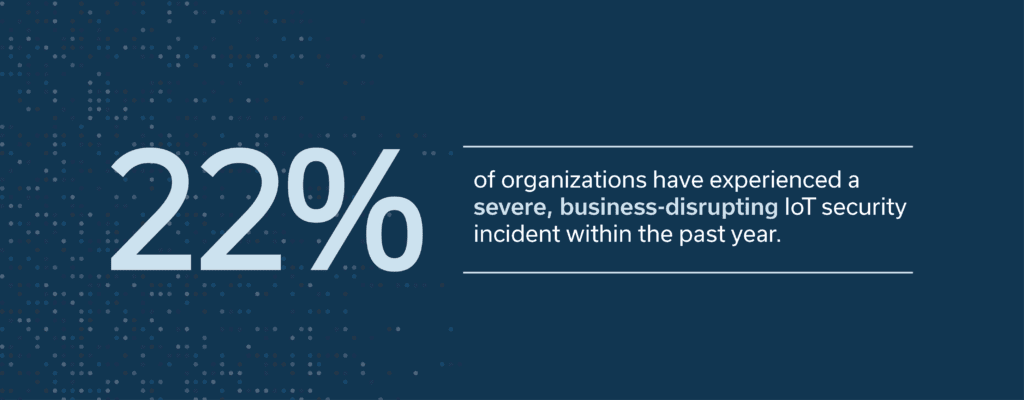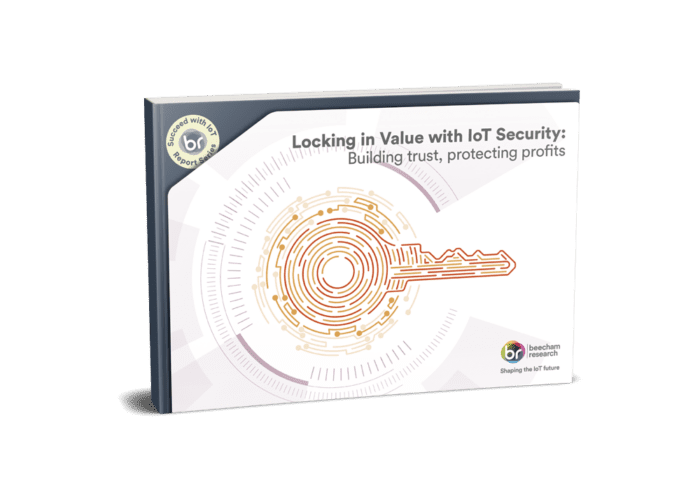- Why Aeris
-
What we offer
Our Platforms & SolutionsAeris Mobility Suite
-
Who we serve
Our Customers & PartnersConnected Industries
- Partner Ecosystem
- About
- Resources
- Login
As we approach 2024, the proliferation of connected devices is set to surpass 17 billion globally, a figure that underscores both the enormous potential and the significant challenges inherent in this technological revolution.
However, this exponential growth in connectivity comes with a commensurate increase in vulnerability. The stark reality is that 22% of organizations have experienced a severe, business-disrupting IoT security incident within the past year alone. As IoT attacks grow in frequency and sophistication, traditional cybersecurity measures no longer suffice. The sheer scale and complexity of IoT networks demand a more robust, multi-layered approach to security.
This article explores the top 10 strategies for securing IoT devices, emphasizing the importance of a multi-layered approach.
Prioritize Security in Choosing a Connectivity Provider
When selecting a connectivity provider, it is crucial to prioritize security. A secure provider can help mitigate many risks associated with IoT deployments. Aeris, for example, offers agentless security solutions that operate on the network level, ensuring comprehensive protection for IoT devices without the need for additional software on each device . By choosing a provider with robust security measures, businesses can ensure their IoT ecosystems remain protected from cyber threats.
IoT security remains a top concern for enterprises, with outdated vulnerabilities posing significant risks. The rapid growth in connected devices highlights the importance of security in connectivity choices.
Network Security vs. Device/Application Security
Understanding the difference between network security and device/application security is essential. While network security focuses on protecting the communication channels, device/application security involves securing the individual IoT devices and the applications they run. Aeris Watchtower emphasizes network-level security, providing a broader protective shield that safeguards multiple devices simultaneously.
IoT devices are often used as entry points for cyberattacks, emphasizing the need for strong network security. Differentiating between these two levels of security helps in implementing targeted measures that address specific vulnerabilities.
Implement Secure Authentication and Access Control
Strong authentication and access control mechanisms are fundamental to IoT security. Multi-factor authentication (MFA) and biometric authentication can significantly enhance security by ensuring that only authorized users and devices can access the network. Role-based access control (RBAC) further restricts access based on user roles, minimizing the risk of unauthorized access.
Robust authentication methods, including MFA, are crucial for securing IoT devices. Effective access control policies reduce the risk of breaches and protect sensitive data.
Regular Firmware and Software Updates
Keeping IoT device firmware and software up-to-date is critical for closing security vulnerabilities. Automated update processes can help ensure that devices always run the latest, most secure versions of their software. This proactive approach can prevent many security issues before they become serious threats.
Regular updates and patches are essential for maintaining the security of IoT devices. Automated updates minimize the risk of devices running outdated, vulnerable software.
Intrusion Detection Systems (IDS)
Intrusion Detection Systems (IDS) provide a critical line of defense against cyber threats. By continuously monitoring network traffic and device behavior, IDS can detect unusual patterns that may indicate a security breach. Real-time alerts allow for swift responses, mitigating potential damage. Considering that the most common security threats to IoT are malware (49%), human error (39%), and DDoS attacks (22%), effective IDS are essential to safeguard IoT environments from these prevalent risks.
IDS systems are vital for real-time threat detection and response in IoT environments. Continuous monitoring helps identify and address security threats promptly.
Secure Boot and Storage Mechanisms
Secure boot processes ensure that only authenticated firmware can run on IoT devices, protecting against unauthorized or tampered firmware. Additionally, encrypting data stored on devices helps safeguard sensitive information from unauthorized access. It’s crucial to consider not only the security of data at rest (stored on the device and servers) but also data in motion (transmitted over connectivity). Ensuring robust encryption during transmission is essential to prevent data breaches and maintain the integrity of sensitive information throughout its lifecycle.
Secure boot mechanisms protect IoT devices from firmware-level attacks. Data encryption is crucial for maintaining the confidentiality and integrity of stored information.
Network Segmentation and Firewalls
Segmenting the network into isolated zones can significantly enhance security. Firewalls play a crucial role in controlling traffic between these segments, preventing unauthorized access and limiting the potential spread of malware.
Equally important is the notion of destination monitoring. Many non-consumer IoT applications have devices that should only send and receive data from a designated application server. This means ensuring devices do not freely wander around the Internet or communicate with unknown sites, which could indicate a breached device. Our solution, Watchtower, is designed to look for and report on such anomalies.
Physical Security Measures
Physical security is often overlooked but is essential for protecting IoT devices from tampering, theft, and other physical threats. Using tamper-resistant hardware and secure enclosures can prevent unauthorized physical access to devices.
Physical Security Measures prevent any unauthorized physical access, tampering or theft. Tamper-resistant designs and secure enclosures enhance the overall security of IoT deployments.
Vendor Risk Management
Evaluating and managing the security practices of third-party vendors is vital for maintaining a secure IoT ecosystem. This includes ensuring that vendors adhere to high security standards and promptly address any vulnerabilities in their products.
Vendor risk management helps mitigate supply chain vulnerabilities and ensures consistent security practices across the IoT ecosystem. Regular assessments of third-party vendors can prevent security breaches originating from external sources.
Security Awareness and Training
Educating employees about IoT security best practices and potential threats is essential for fostering a culture of security. Regular training programs can help staff recognize and respond to security incidents, reducing the risk of human error.
Security awareness and training programs are effective in reducing the risk of insider threats and human error. A well-informed workforce is a critical component of a comprehensive IoT security strategy.
Final Words
Implementing these top 10 strategies can significantly enhance the security of IoT deployments. By prioritizing security in connectivity choices, understanding different levels of security, and adopting robust authentication, update, and monitoring practices, businesses can protect their IoT ecosystems from a wide range of cyber threats. Additionally, focusing on physical security, vendor management, and employee training ensures a comprehensive approach to IoT security.
Ensuring robust IoT security is not just about protecting devices but also about safeguarding the entire network and the sensitive data it holds. By staying vigilant and proactive, organizations can mitigate risks and secure their IoT infrastructure against emerging threats.
Aeris IoT Watchtower
Enhance the security and efficiency of your IoT deployments with Aeris’ industry-leading connectivity management solutions. Experience unparalleled network security, real-time monitoring, and seamless device management designed to protect your IoT ecosystem from emerging threats.
Don’t wait—secure your connected future today. Request a demo of Aeris IoT Watchtower now and see how Aeris can transform your IoT security strategy.



